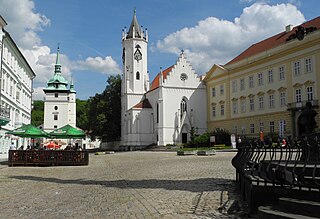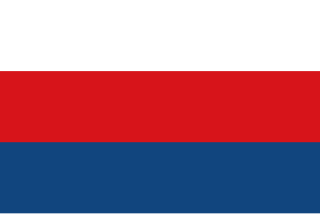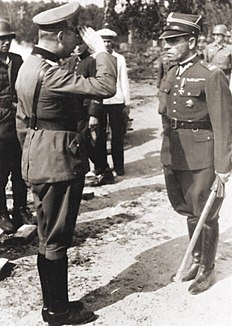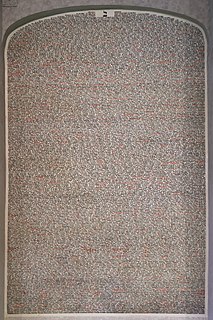
Teplice, Teplice-Šanov until 1948, is a statutory city in the Ústí nad Labem Region of the Czech Republic and the capital of the Teplice District. It is Czech Republic's second largest spa town, after Karlovy Vary.

The Protectorate of Bohemia and Moravia was a partially annexed territory of Nazi Germany established on 16 March 1939 following the German occupation of the Czech lands on 15 March 1939. Earlier, following the Munich Agreement of September 1938, Nazi Germany had incorporated the Czech Sudetenland territory as a Reichsgau.

Litoměřice is a town at the junction of the rivers Elbe and Ohře in the northern part of the Czech Republic, approximately 64 km (40 mi) northwest of Prague.

Alois Eliáš was a Czech General and politician. He served as Prime Minister of the puppet government of the German-occupied Protectorate of Bohemia and Moravia from 27 April 1939 to 27 September 1941, but maintained contact with the government-in-exile. Because of his participation in the anti-Nazi resistance, he was the only head of government to be murdered by the Nazis during the war.
Jaroslav Krejčí was a Czech lawyer and Nazi collaborator. He served as Prime Minister of the Protectorate of Bohemia and Moravia from September 28, 1941 to January 19, 1945.

There is evidence that Jews have lived in Moravia and Bohemia since as early as the 10th century. As of 2005, there were approximately 4,000 Jews living in the Czech Republic.

The German Social Democratic Workers' Party in the Czechoslovak Republic was a German social democratic party in Czechoslovakia, founded when the Bohemian provincial organization of the Social Democratic Workers' Party of Austria separated itself from the mother party. The founding convention was held in Teplice from 30 August – 3 September 1919; the first leader of the party was Josef Seliger.

Český národně socialistický tábor — Vlajka was a small Czech fascist, antisemitic and nationalist movement. Vlajka's eponymous newspaper was founded in 1928, its first editor being Miloš Maixner. During the time of German occupation, the organisation collaborated with the Nazis for which it was banned and its members were punished after the liberation.

Friedrich-Georg Eberhardt was a German Generalleutnant who commanded the following divisions during World War II; the 60th Infantry Division, 38th Infantry Division, 174th Reserve Division, and 286th Security Division. He was sent four times to the Führerreserve.
Georg Herbert Mehlhorn was an SS Oberführer, Nazi legal expert, and Gestapo official. Mehlhorn was involved in the camouflage of the mass graves of the Jewish victims in the forest of the Chełmno extermination camp. He operated gas wagons at the Chełmno camp to murder the sick Jewish prisoners who were sent from the Wartheland ghettoes. He was also a director of Stiftung Nordhav, a front organization of the Sicherheitsdienst founded in 1939 by Reinhard Heydrich, one of the main architects of the Holocaust. He was the mentor of SS-Brigadeführer Walter Schellenberg while at the SS-Hauptamt.

The Holocaust in the Protectorate of Bohemia and Moravia resulted in the deportation, dispossession, and death of 80,000 Jews. It was carried out by Nazi Germany, which was occupying the country, with some collaboration by the Czech collaborationist government.

The Holocaust in the Sudetenland resulted in the flight, dispossession, deportation and ultimately death of many of the 24,505 Jews living in the Reichsgau Sudetenland, a Nazi German administrative region established from former Czechoslovak territory annexed after the October 1938 Munich Agreement. Due to harassment and violence, including during Kristallnacht, ninety percent of the Jews had already left the Sudetenland by mid-1939. The remaining Jews were subject to property confiscation and eventually deportation. During the later years of the war, tens of thousands of Jews and non-Jews were forced laborers in a network of concentration camps in the Sudetenland.
Wolf Gruner is a German academic who has been the Founding Director of the Center for Advanced Genocide Research at the University of Southern California Shoah Foundation since 2014. He currently holds the Shapell-Guerin Chair in Jewish Studies and is also Professor of History at USC. Since 2017, he is a member of the Academic Advisory Committee of the Center for Advanced Holocaust Studies at the United States Holocaust Memorial Museum.

Arijský boj was a pro-Nazi Czech-language weekly tabloid newspaper published between May 1940 and May 1945 in the Protectorate of Bohemia and Moravia. Inspired by Der Stürmer, the newspaper made antisemitism its main theme and was also critical of the Czechoslovak government-in-exile. Denunciations published by the newspaper contributed to the isolation of Jews during the first years of the Holocaust in Bohemia and Moravia.

Leitmeritz was the largest subcamp of the Flossenbürg concentration camp, operated by Nazi Germany in Leitmeritz, Reichsgau Sudetenland. Established on 24 March 1944 as part of an effort to disperse and increase war production, its prisoners were forced to work in the caverns Richard I and II, producing Maybach HL230 tank engines for Auto Union and preparing the second site for intended production of tungsten and molybdenum wire and sheet metal by Osram. Of the 18,000 prisoners who passed through the camp, about 4,500 died due to disease, malnutrition, and accidents caused by the disregard for safety by the SS staff who administered the camp. In the last weeks of the war, the camp became a hub for death marches. The camp operated until 8 May 1945, when it was dissolved by the German surrender.

From 4 to 7 November 1938, thousands of Jews were deported from Slovakia to the no-man's land on the Slovak−Hungarian border. Following Hungarian territorial gains in the First Vienna Award on 2 November, Slovak Jews were accused of favoring Hungary in the dispute. With the help of Adolf Eichmann, Slovak People's Party leaders planned the deportation, which was carried out by local police and the Hlinka Guard. Conflicting orders were issued to target either Jews who were poor or those who lacked Slovak citizenship, resulting in chaos.
The Greater German Reich and the Jews: Nazi Persecution Policies in the Annexed Territories 1935–1945 is a book about the Holocaust in areas annexed by Nazi Germany. The book's chapters are arranged in chronological order by annexation date and cover the Saarland, Austria, the Sudetenland, Protectorate of Bohemia and Moravia, Memel Territory, Danzig and West Prussia, the Warthegau, Zichenau, East Upper Silesia, Eupen-Malmedy, Luxembourg, and Alsace-Lorraine. It was first published in German in 2010; an English translation was published in 2015. The book was edited by Jörg Osterloh and Wolf Gruner. The book received generally favorable reviews.

The Holocaust in Bohemia and Moravia: Czech Initiatives, German Policies, Jewish Responses is a book by the German historian Wolf Gruner on the Holocaust in the Protectorate of Bohemia and Moravia, the Czech-majority parts of Czechoslovakia partially annexed into Nazi Germany during the German occupation of Czechoslovakia. Beginning before the Munich Agreement, Gruner's book covers the various stages of persecution of Jews which led to their deportation and murder. He argues that the role of Czech collaboration and local initiatives was greater than has been conventionally assumed, and also that Jewish resistance to persecution was substantial. The book has received mixed reviews; some Czech historians have disagreed with Gruner's conclusions while other reviewers generally praised the book with some reservations. The book was published in German in 2016 and in English and Czech in 2019. It received the 2017 Sybil Halpern Milton Memorial Book Prize of the German Studies Association.

The Holocaust in East Upper Silesia resulted in the murder of most of the Jews living in East Upper Silesia during World War II. It is best known as the site of Auschwitz concentration camp, but it also hosted many of the forced-labor camps of Organization Schmelt and seventeen ghettos, including Sosnowiec Ghetto, Będzin Ghetto, and Dąbrowa Górnicza Ghetto. Part of the region had been in Poland before World War II and other parts in Germany.

The Holocaust in Germany was the systematic persecution, deportation, imprisonment, and murder of Jews in Germany as part of the Europe-wide Holocaust perpetrated by Nazi Germany. The term typically refers only to the areas that were part of Germany prior to the Nazi regime coming to power and excludes some or all of the territories annexed by Nazi Germany, such as Austria or the Protectorate of Bohemia and Moravia.















